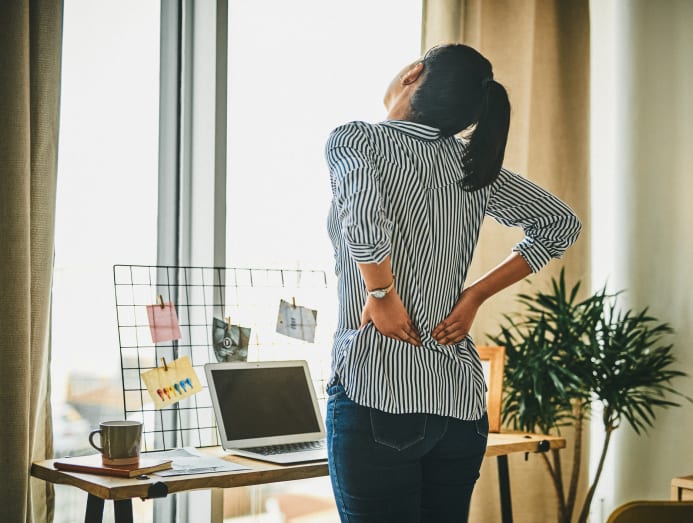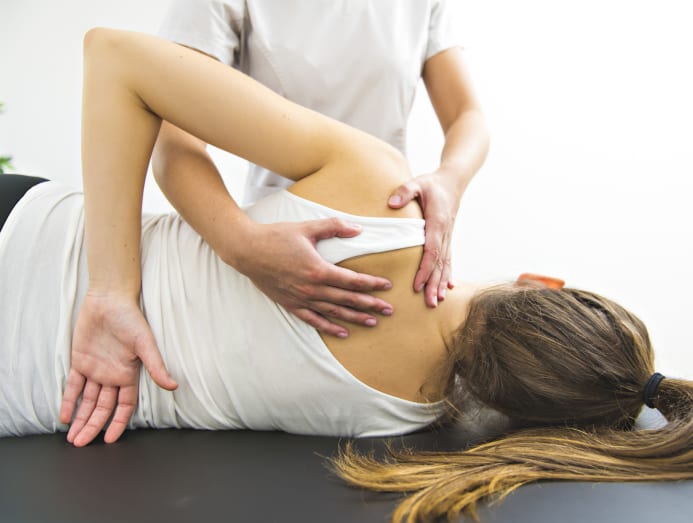Back pain in women: How chiropractic, osteopathy or physiotherapy can help
Back conditions aren’t exclusive to women but they may be more prone to them because of factors ranging from anatomy to hormonal changes during pregnancy. CNA Women takes a look at three options to deal with it.

From prolonged periods of time at the desk to pregnancy and childbirth, these significant changes can lead to back pain in women. (Photo: iStock/shih-wei)
Have you tried doing your own spinal “cracks” at home, applying a pain relief cream or even changing your pillows to alleviate your back pain?
If you have, you are not alone – prolonged sitting from working at home has created an increasing demand for back pain solutions.
When you take away your regular commute to the office or going out on your lunch break, you’ve effectively reduced incidental exercise, said Johnathan Wilson, an osteopath at Orchard Health Clinic, which offers chiropractic, osteopathy and physiotherapy care.
Women, on top of prolonged sitting at their desks, are also more prone to back pain due to changes during pregnancy or menopause.
Pregnancy-related conditions such as sacroiliac joint (SIJ) dysfunction, which occurs when the pelvis adapts to the growing baby, is a common cause of lower back pain, said Aman Bancil, an osteopath and co-founder of Edge Healthcare, an osteopathy and physiotherapy clinic.
Additionally, women going through menopause are more prone to osteoporotic compression fracture, which refers to small cracks that can occur in the vertebrae due to osteoporosis, he added.
"Postmenopausal women experience hormonal changes (including oestrogen reduction) that decreases their bone mineral density, making them more prone to these fractures than men," explained Bancil.
So the question is: What are possible ways for women to treat back pain?
The first thing you need to do is get to the root of the problem, said Dr Matt Kan, founder and chief executive of Chiropractic First. It’s not enough to simply change your work chair or go for a massage, he added.
Chiropractor Dr Benjamin Tan, the founder of Chirogenesis, said that while using an ergonomic chair is beneficial to support your back, it is not able to treat your back pain.
LOWER BACK PAIN IN WOMEN
There are no back conditions that are exclusive to women, said Edge Healthcare’s Bancil, although women may be more prone to them, due to postural and hormonal changes during pregnancy, as well as structural anatomical differences in the hips and pelvis.
Here’s a closer look at what could be causing your back pain.
- Pregnancy. Lower back pain is common due to the extra load on the abdomen, which puts undue pressure on the lower back, said Chiropractic First’s Dr Kan.
- Epidural during labour. This may also cause potential problems, added Dr Kan, as this pain relief option administered to the lower back may cause scarring and adhesion at the injection site. This in turn can affect the ligament tissue of the spinal disc, causing lower back pain.
- Scoliosis. This is a condition that affects the alignment and symmetry of the spine, said Orchard Health Clinic’s Wilson, and is usually detected during the developmental years. It is monitored until the skeletal system is fully mature at around 15 to 17 years old. “Having an osteopath, physiotherapist or chiropractor can help with both manual therapy and exercise prescriptions to manage the condition throughout your life.”
- Hormones. Lower back pain as a result of premenstrual syndrome (PMS) can have its roots in the spine, said Dr Tan of Chirogenesis. “If that area of the spine lacks nerve control, it could cause irregular (and painful) periods, bloating, random spotting, development of cysts, infections and more.”
To find out more, CNA Women delved into how a chiropractor, osteopath or physiotherapist can help alleviate back pain. All these are non-invasive treatments.
CHIROPRACTIC
Chiropractic aims to keep your spine and nervous system healthy.
According to the Chiropractic First website, when the bones in the spine (called the vertebrae) are out of alignment due to poor posture, stress, trauma, childbirth and other reasons, it causes what’s called subluxations.
“Chiropractic adjustments (to correct these subluxations) have been proven to be highly effective to help reduce and alleviate the pain,” said the clinic’s Dr Kan.

To better explain what chiropractic is, Dr Tan from Chirogenesis said that everything in your body is directly (or indirectly) controlled by your spine and nerves – including the shedding of the uterus lining during menstruation.
Think of a chiropractor as a "doctor of the nervous system" more than just a spinal doctor, said Dr Tan.
Put in layman terms, if your spine and nervous system are healthy, the rest of your body would be too since everything is inter-connected. Chiropractors say that one would subsequently not need to depend on drugs, medication or surgery.
Some benefits you can enjoy from chiropractic care over a period of time include a realigned, stabilised spine, being able to return to full function and enjoying physical activities freely, said Dr Kan.
Chiropractic may also be helpful in pregnancy, where more frequent maintenance of the spine is required due to the additional weight from the abdomen, he added. The extra weight “puts a lot of pressure on the lower back, causing persistent, intense and unbearable pain”.
Chiropractic care can also help with old injuries or treat complications from an epidural, he added.
A US clinical paper studying the benefits of chiropractic care in 950 women during pregnancy and labour in 2007, suggested that chiropractic was the third most common form of treatment after yoga and massage.
The same study also highlighted that women who seek chiropractic care throughout their pregnancy have, on average, 31 per cent shorter labour times.
This rings true for 42-year-old mumpreneur Nichol Ng, who started chiropractic sessions in 2016, when she was pregnant with her third child. “I believe it contributed to a swifter birth experience without any epidural or painkillers,” she added.
Ng continued with her chiropractic sessions during her confinement and throughout her fourth pregnancy as well.
OSTEOPATHY
Osteopaths focus on the musculoskeletal system, which includes the bones, muscles, tendons, ligaments and soft tissues. To help with back pain, they use soft tissue techniques, deep tissue manipulation, articulations and mobilisations, explained osteopath Wilson.
During pregnancy, said Bancil, an osteopath would work on gently releasing the tissue around the hips and spine, help with joint mobility and postural strengthening, and give exercise advice.

As with chiropractic, these measures are used to mitigate the impact of the added weight the body has to adapt to during pregnancy. “This alone can put stress on the lower back, but it also changes the centre of gravity, which then has secondary consequences on other parts of the spine," said Wilson.
In postpartum back pain, it is the abdominal wall that’s largely affected, especially if you’ve had a Caesarean delivery. “An exercise programme to help build up the core muscles again would be key,” Bancil said.
There’s some crossover between osteopathy, physiotherapy and chiropractic. Osteopaths and physiotherapists also “administer adjustments to the spine and other parts of the body when necessary”, said osteopath Wilson.
And while historically, osteopaths would use a more manual approach while physiotherapists utilised exercise rehabilitation, both now tap on both approaches, said Bancil.
PHYSIOTHERAPY
One of the biggest misconceptions of physiotherapists is that they don’t treat back problems because they don't typically “crack” backs, said Bancil of Edge Healthcare.
“Physiotherapists are movement experts and utilise multiple other ways to improve back pain through soft tissue techniques, exercise prescription, as well as education and advice,” he added.
Although their titles differ, both physiotherapists and osteopaths can assist in the recovery and rehabilitation of back pain, said Wilson of Orchard Health Clinic.
And both types of therapists are trained to diagnose and treat a wide array of musculoskeletal issues and injuries, added Bancil, whether it’s conditions related to the joints or muscle-related pain, sports injuries or postural problems.
“As a result, they are able to treat anything from an elderly person’s knee complaint to a high-level athlete’s shoulder pain,” he added.
YOU CAN GO FOR MORE THAN ONE TYPE OF TREATMENT
It’s worth noting that a therapist in one field may also refer a patient to one in another field, depending on what treatment is needed.
For example, Chirogenesis’ Dr Tan said it’s not uncommon for him to recommend that a patient with a sports injury visit a physiotherapist as well.

This pairing isn’t unusual. Dr Kan explained that in countries like Australia, and increasingly in Malaysia, physiotherapists work with chiropractors. “Chiropractors work on the biomechanical function of the spine whereas physiotherapists help with soft tissue rehabilitation, muscle stretching and mobility.”
A session with a chiropractor, osteopath or physiotherapist varies among different clinics in Singapore. For instance, Chirogenesis charges S$110 for a 20- to 30-minute session, while at Edge Healthcare, patients pay S$160 for a 40-minute session. Meanwhile, each session at Orchard Health Clinic costs S$214 for an hour.
Most clinics offer packages, too, although some claim that they do not actively sell them. “We try to get people as independent as quickly as possible,” said Edge Healthcare’s Bancil, whose clinic offers a package of S$1,400 for 10 sessions. Chirogenesis charges S$288 for three sessions.
WHEN TO SEEK HELP FOR YOUR PAIN
Whether you choose to see a chiropractor, osteopath or physiotherapist, the best time to seek help is before the pain surfaces, in what’s called preventative wellness care, said Dr Kan.
“Having a general check-up to ascertain how to best manage your musculoskeletal well-being during any stage of life can be beneficial to prevent future injury,” advised Wilson from Orchard Health Clinic.
Obviously, if you’re already in pain, you shouldn’t ignore it.
Citing an example, Dr Kan said: “When a patient tells me that he felt a little numbness on his finger that started recently, the problem has been there for a long time. The nerve is compressed and badly damaged even before the patient even feels it.”
According to osteopath Bancil, you should consult a physiotherapist or osteopath if:
- Your pain gets worse with a particular movement or activity.
- Your pain is not getting better (or gets worse) within a few days.
- Your pain is very severe and affects your movements.
- Your pain has been going on for a long time.
Said Orchard Health Clinic’s Wilson: “(With osteopathy), we aim to not only treat but educate and empower the patient on how to manage their overall musculoskeletal health.”
Will the pain return? It’s possible, said chiropractor Dr Tan, which is why education and changing perceptions are equally important in these sessions.
RELATED:
Just like a toothache, if the problem is detected early, it can be corrected and reversed very quickly, said chiropractor Dr Kan. But if the problem has been there for a long time, it would take longer.
As a rough indication, if you went to an osteopath to treat a minor joint irritation, it could take up to two weeks to resolve. In contrast, “a slipped disc can take about six months”, said Edge Healthcare’s Bancil.
CNA Women is a section on CNA Lifestyle that seeks to inform, empower and inspire the modern woman. If you have women-related news, issues and ideas to share with us, email CNAWomen [at] mediacorp.com.sg.







